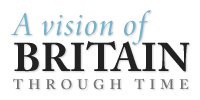In 1887, John Bartholomew's Gazetteer of the British Isles described Cambridge like this:
Cambridge.-- parl. and mun. bor., and co. town of Cambridgeshire, on the river Cam, 56 miles N. of London by rail -- parl. bor., 4001 ac., pop. 40,878; mun. bor., 3278 ac., pop. 35,363; 4 Banks, 5 newspapers Market-days, Tuesday and Saturday. It was anciently a Roman station, was burned by the Danes in 871 and 1010, and was made the site of a castle by William the Conqueror. ...
The city has long been famous as the seat of a university. Its trade is derived from the university, and from its being the centre of an agricultural district. Before the railways it had a very considerable business by river with King's Lynn. It is now a chief station on the Great Eastern line, and is also connected with the other main lines. It has no mfrs. Jeremy Taylor (1613-1667) was a native. The bor. returns 1 member to Parliament.-- The University of Cambridge consists of 17 colleges, each of which is governed by its own rules and customs. The 17 colleges are: -- St Peter's or Peter House (founded in 1257), Clare (1326), Pembroke (1347), Gonville and Caius (1348), Trinity Hall (1350), Corpus Christi (1352), King's (1441), Queen's (1448), St Catherine's (1473), Jesus (1496), Christ's (1505), St John's (1511), Magdalene (1519), Trinity (1546), Emmanuel (1584), Sidney Sussex (1598), Downing (1800), and Cavendish (1873). There are also 2 colleges -- Girton (3 miles from Cambridge) and Newnham -- for women, who, after their course of study and on passing the examinations, receive a certificate; but no degree is conferred upon them. The library contains upwards of 300,000 volumes, besides many valuable MSS. The laboratories and museums for the study of the natural sciences are splendidly equipped. The number of undergraduates is about 2500. The University returns 2 members to Parliament.
Cambridge through time
Click here for graphs and data of how Cambridge has changed over two centuries. For statistics for historical units named after Cambridge go to Units and Statistics.
GB Historical GIS / University of Portsmouth, History of Cambridge in Cambridgeshire | Map and description, A Vision of Britain through Time.
URL: https://www.visionofbritain.org.uk/place/1021
Date accessed: 10th May 2024
Not where you were looking for?
Click here for more detailed advice on finding places within A Vision of Britain through Time, and maybe some references to other places called "Cambridge".
